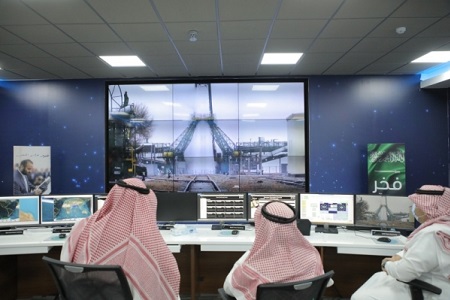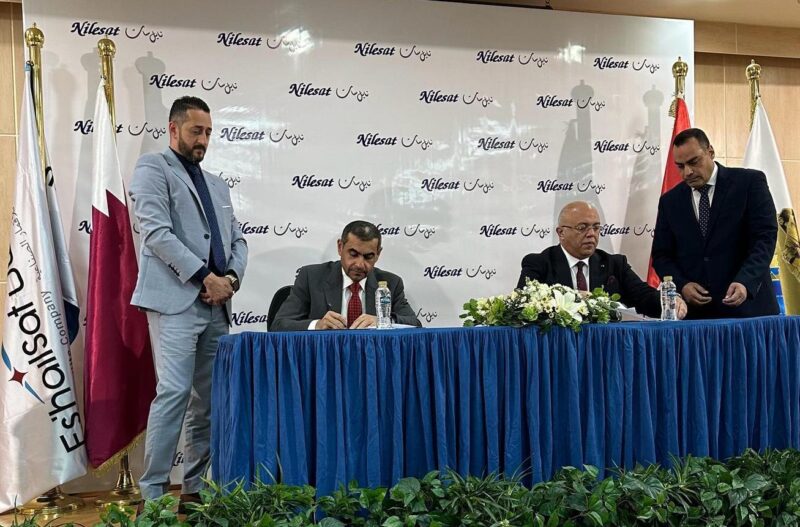Update on the Middle East Satellite Market
by Elisabeth Tweedie
Dubai, UAE, May 20, 2024--Looking at recent developments in the satellite market in the Middle East, two words spring to mind: growth and partnerships. In a white paper “Beyond the Stars,” written for the Sultanate of Oman, Novaspace (formerly Euroconsult)describes the Middle East as a “global hotspot for space activities.” The space economy in the region has tripled in the last decade to an estimated value of US$ 25 billion in 2023, and is expected to reach US$ 75 billion by 2032.
A significant portion of this growth can no doubt be attributed to the region’s governments desire to diversify their economies and lessen the reliance on hydrocarbons. This is reflected in the significant investment that has been made in the space sector; US$1.4 billion last year, up from US$696 million in 2010, and projected to double to US$2.8 billion by 2032.
 |
The very fact that this white paper was written for the Sultanate of Oman, is in itself somewhat surprising, as Oman is not one of the first countries that springs to mind when thinking of the satellite industry in the Middle East. The fact that one of the prominent Sovereign Wealth funds investing in space, is also that from Oman is equally surprising.
Oman’s first satellite, Aman-1, an earth observation (EO) nano-satellite was launched by SpaceX at the end of last year, and is now operational and transmitting images. However, the choice of SpaceX to launch Aman-1 is not surprising given that the Omani Investment Authority, (OIA, the sovereign wealth fund of Oman) took an equity stake in SpaceX in 2021. The size of the investment has not been disclosed, but at the time the OAI stressed that the investment was intended to provide more than financial returns. A post by the OIA stated: “The investment will advance by benefitting from technologies owned by the company and create potential opportunities to transfer the company’s expertise and experience locally, which leads to opening the prospects for foreign investments.”
"...the space economy in the Middle East has tripled in the last decade to an estimated value of US$ 25 billion in 2023, and is expected to reach US$ 75 billion by 2032..."
Oman’s space ambitions, however are more extensive than just one nano-satellite. It is building a spaceport, known as Etlaq at the coastal town of Duqm, which is planned to be operational by 2030. It is being designed to accommodate all sizes of launch including large commercial ones. The location is a good one; 19oS, closer to the equator than the Kennedy Space Center in Florida and also adjacent to a large body of water to the east. However, before US companies can take advantage of the site, Oman will have to reach agreement with the US on ITAR regulations. As well as a spaceport, there are plans for manufacturing, launch services and the construction and operation of ground stations in Oman and the Middle East. These are the result of a collaborative venture between ETCO (the entity responsible for Aman-1) and two Polish Companies (SatRev and Tuatara). The joint venture is known as Spazers.
Arabsat
Oman, is by no means the only country in the Middle East pursuing collaboration and partnerships, Arabsat, the region’s largest operator with eight satellites, covering 100 countries, has not been sitting on its laurels. Last September, it effectively relaunched itself with a new brand identity, stating its ambition is to “position Arabsat as a guiding light for shaping the future, amplifying communication values and fostering unity among nations.” It is aiming to position itself as “the premier platform in the global satellite communication arena.” Several new collaborative ventures and partnerships have been announced since then, including those with TVU Networks and Zixi, and Nilesat.
Partnering with TVU Networks, a cloud-based workflow provider and Zixi a company that specializes in live broadcast-quality video delivery over IP, Arabsat launched a new global content delivery platform, to make it easier for TV channels to share their content, in any video format, anywhere in the world.
Arabsat also signed a strategic partnership and joint cooperation agreement with the Egyptian Operator, Nilesat, intended to enhance broadcasting and communication services across the region. This agreement was made public on March 4th this year. March was a busy time for Nilesat, as the day before, it announced that it had signed a Memorandum of Understanding (MOU) with the Qatari operator, Es’hailSat for “cooperation and integration.” That collaboration covers video streaming, satellite communications, and digital technologies, amog others, across the Middle East and North Africa.
Qatari operator Es’hailSat signed a Memorandum of Understanding (MOU) in February this year with the Egyptian operator, Nilesat for cooperation and integration that covers video streaming, satellite communications, and digital technologies, among others, across the Middle East and North Africa.
Arabsat’s satellites are all geostationary, but in March it signed an MOU with the Canadian operator Telesat, establishing a long-term strategic partnership to collaborate on efforts to commercialize Lightspeed, Telesat’s low earth orbit (LEO) constellation. The constellation will have 198 satellites, the first of which are scheduled to launch in 2026. The MOU also covers cooperation on technical aspects, orbital resources and regulations.
United Arab Emirates
The United Arab Emirates (UAE) government is also making a significant investment in satellite communications. It already has contracts with Yahsat, but these are due to expire in 2026. Last September it pledged US$5.1 billion to buy broadband services from the operator until at least 2043.
Yahsat is planning to use the investment to fund two GEO satellites from Airbus, Al Yah 4 and Al Yah 5. These are slated to “surpass current industry capabilities, including capacity, coverage and flexibility.” Announcing the investment, Yahsat CEO Ali Al Hashemi said the investment would enable the company to provide “broader, more diverse and cutting-edge solutions portfolio to both the government and our customers.” Currently around 75% of Yahsat’s revenue comes from government customers, but the company has said that ultimately it hopes to have a 50-50 government-commercial split.
Maybe bolstered by this guaranteed revenue stream, in February of this year, Yahsat announced Project SKY, its direct to device (D2D) strategy. In the announcement the company said that it “is primed to transform the lives of billions of people and accelerate internet-of-things (IoT) growth.”
Yahsat’s subsidiary Thuraya, has been providing a D2D service since 2013 in its coverage area. This is via SatSleeve, a device containing an L-band antenna, which can be added to a smart phone and provides satellite voice, data and texting when out of cellular coverage. SKYPHONE (the device for Project SKY) is a dual SIM Android smartphone with an integrated antenna for satellite voice and SMS. The cellular SIM can come from any of Thuraya’s cellular partners.
Phase One of Project SKY will offer voice and messaging capabilities this year, followed by texting and IoT capabilities in 2025. Service was intended to be supplied from its GEO satellites, Thuraya 2 and 3, then Thuraya 4 which is scheduled for a December launch. However, on April 23rd Thuraya 3, which is already at the end of its lifespan, suffered a major anomaly, cutting off all services to many countries. It is not yet clear how or if, this will impact Phase One. Thuraya is an investor in Astrocast, which operates a LEO smallsat constellation for IoT, so this may be integrated into the service for IoT connectivity and services. Phase two, known as Project BlueStar aims to enable full D2D connectivity “through a scalable and sustainable satellite network.”
Space42
Important and interesting, though all these partnerships are, the most ambitious, and probably the most surprising, also comes from Yahsat, which is merging with Bayanat to create a new entity Space42. In the documents released describing the merger, Bayanat is described as a company providing “comprehensive world-class AI-powered geospatial solutions to a growing number of sectors such as government services, environment, energy and resources, smart cities and transportation. Its offering includes topographic, hydrographic and aeronautical products and charts, as well as spatial data surveying, analysis, management modeling, visualization and cartography services. Bayanat’s solutions harness vast amounts of premium and unique data from a range of sources including various types of satellites such as synthetic aperture radar (SAR) satellite, optic satellite as well as high altitude pseudo satellites (HAPS) and conventional mapping and surveying powered by AI to drive geospatial intelligence (gIQ).”
Also in those documents, Space42 is described as “an AI-powered space technology champion in the MENA region with additional potential for significant global growth and synergies. With a strengthened financial position, enhanced AI-powered technological capabilities and a diversified product portfolio, the combined entity will be vertically integrated and optimally positioned to capture regional and international opportunities in geospatial and mobility solutions, satellite communications and business intelligence. It is expected to benefit from considerable revenue synergies and economies of scale that will best position the organization for innovation and profitable growth.”
The market capitalization of Space42 is expected to be around US$ 4 billion, with revenues of around US$ 700 million. Karim Michel Sabbagh, a former President and CEO SES is the Managing Director Designate of the new company. Immediately before joining Space42 Sabbagh was CEO of eSpace.
At first glance this seems like an extraordinary move, by a communications satellite company, but in fact Yahsat’s interest in geospatial started in 2021 when the government services arm of Yahsat and G42 “the leading UAE based AI and cloud computing company” signed an MoU to collaborate on advancing remote sensing and geospatial capabilities. G42 is also the majority shareholder in Bayanat (which is doubtless where the name
“Space42” came from). According to Forbes, G42 is a technology holding company, chaired by a member of Abu Dhabi’s royal family and backed by Mubadala. It has partnerships with many international companies, including OpenAI, Dell, Microsoft, Nvidia, Oracle, Cerebras, AstraZeneca, Illumina and Mercedes.
That MoU was followed up in February of last year, by an announcement by Yahsat that it was partnering with the Mohammed Bin Rashid Space Center (MBRSC) on remote sensing and earth observation. Under the agreement, Yahsat gained the right to commercialize EO data from MBRSC and also created the potential for R&D collaboration.
Then in May last year Yahsat, Bayanat and ICEYE (a Finnish manufacturer of synthetic aperture radar (SAR) satellites) announced plans to develop a comprehensive space program aimed at building national satellite remote sensing and EO capabilities for the UAE to commercially address opportunities in the local and global EO market. The initial constellation was to be five LEO satellites, but this has since been expanded to seven. So maybe merging with Bayanat was not such an extraordinary move after all.
The merger was approved by shareholders of both entities on April 25th. Announcing the agreement, Sabbagh said: "Bayanat and Yahsat have laid strong foundations for SPACE42 to build upon with enormous potential to disrupt the space-tech industry. With the combined expertise of both businesses, SPACE42 brings a unique offering to the market, merging satellite communications, geospatial intelligence and AI to pioneer innovative solutions. The merger marks a significant step for shareholders and underscores our commitment to advance the UAE’s position as a global AI-powered SpaceTech leader."
As I said, growth and partnerships. It will be interesting to see how many new strategic alliances and partnerships are forged at this year’s Cabsat.
------------------------------
 Elisabeth Tweedie has over 20 years experience at the cutting edge of new commmunications and entertainment technologies. She is Associate Editor of the Satellite Executive Briefing and the founder and President of Definitive Direction (www.definitivedirection.com), a consultancy that focuses on researching and evaluating the long-term potential for new ventures, initiating their development, and identifying and developing appropriate alliances. During her 10 years at Hughes Electronics, she worked on every acquisition and new business that the company considered during her time there. She can be reached at etweedie@definitivedirection.com
Elisabeth Tweedie has over 20 years experience at the cutting edge of new commmunications and entertainment technologies. She is Associate Editor of the Satellite Executive Briefing and the founder and President of Definitive Direction (www.definitivedirection.com), a consultancy that focuses on researching and evaluating the long-term potential for new ventures, initiating their development, and identifying and developing appropriate alliances. During her 10 years at Hughes Electronics, she worked on every acquisition and new business that the company considered during her time there. She can be reached at etweedie@definitivedirection.com






